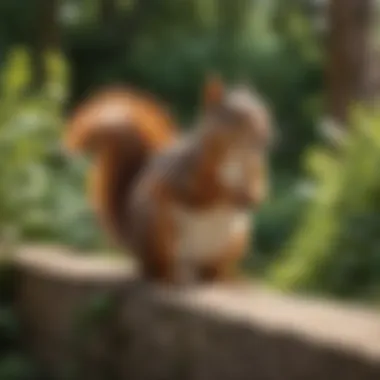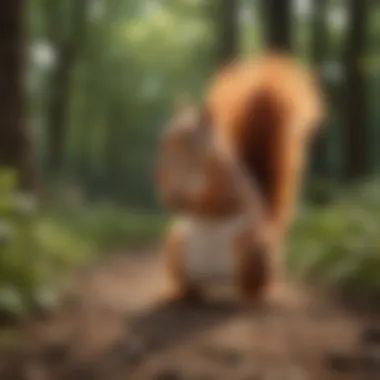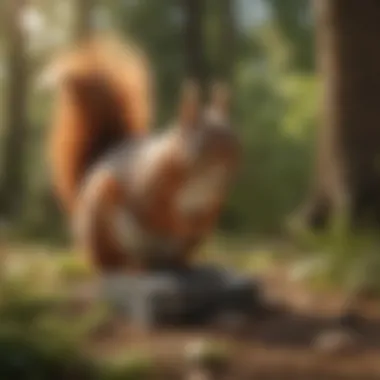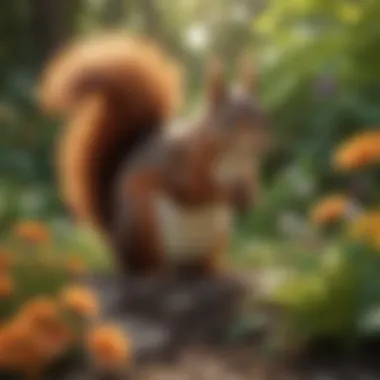Top Strategies to Deter Squirrels in Your Garden


Intro
Squirrels can be a significant challenge for gardeners. These playful creatures often dig up bulbs, nibble on seeds, and even raid vegetable patches. As such, finding effective strategies to deter them is essential for maintaining a flourishing garden. This article aims to present a well-rounded examination of various deterrent methods available. By analyzing physical barriers, natural repellents, electronic devices, and companion planting techniques, gardeners can find suitable solutions that align with their gardening philosophy and environmental considerations.
Understanding these methods is critical. Not all strategies are equally effective in every situation. Factors like local squirrel populations, garden layout, and personal preferences can influence the choice of deterrence measures. This guidance serves homeowners, gardening enthusiasts, and eco-conscious individuals looking to protect their plants.
Throughout the article, we will dig deep into the practicality and effectiveness of each option, ensuring that this resource provides actionable insights. The goal is to enhance readers' knowledge, empowering them to make informed decisions tailored to their gardens and lifestyles.
Understanding Squirrel Behavior
To combat squirrel invasions effectively, it is vital to understand their behavior. Squirrels are food-driven creatures. They often search for nuts, seeds, and other edibles. Knowing this can help gardeners devise proactive measures to keep these animals at bay.
Squirrel Eating Habits
- Diet: Squirrels primarily feast on seeds, nuts, fruits, and fungi. Identifying food sources can help inform deterrent strategies.
- Caching: These animals store food for winter. This caching behavior can lead them to dig in search of buried items, causing damage to garden beds.
- Time of Activity: Squirrels are most active early in the morning and late afternoon. Understanding their active periods can guide gardeners in planning protective measures.
Through this knowledge of squirrel behavior, gardeners can implement targeted strategies to reduce encounters with these persistent pests. This approach ensures a more harmonious relationship with local wildlife while protecting precious garden investments.
Understanding Squirrel Behavior
Understanding squirrel behavior is essential for anyone who wishes to maintain a thriving garden. Squirrels are known for their inquisitive nature and their clever methods of accessing food sources. Knowing their habits can guide gardeners in implementing effective deterrent strategies. Gaining insights into why and how squirrels invade gardens allows for more tailored approaches to protection.
Why Squirrels Invade Gardens
Squirrels invade gardens primarily in search of food. They are opportunistic feeders, readily adapting to available resources. In urban and suburban environments, gardens often become attractive food sources. Common targets include fruits, vegetables, and nuts. Additionally, squirrels might invade gardens during mating seasons or harsh weather conditions, as they seek safe havens with ample food supply.
Female squirrels particularly may look for locations to raise their young, leading them to gardens rich in edible plants. Understanding these motivations helps gardeners anticipate squirrel behavior and devise preventive measures.
Common Garden Damage Caused by Squirrels
The damage caused by squirrels can be quite varied and significant. Some common issues include:
- Digging up bulbs and roots: Squirrels often excavate to reach bulbs or root systems, causing chaos in flower beds and vegetable patches.
- Eating fruits and vegetables: Garden produce, such as tomatoes and strawberries, often becomes a target. Squirrels bite into fruits, making them inedible or just downright unpleasant to consume.
- Gnawing on plants: To keep their teeth trimmed, squirrels gnaw on tree bark and softer stems, which can cause significant harm to young or fragile plants.
In some cases, this behavior leads to large-scale destruction, leaving gardeners frustrated.
"Understanding what attracts squirrels is key to developing practical solutions for your garden."
Through comprehension of these behaviors and tendencies, gardeners can strategically protect their plants. Effective deterrents arise from a deep understanding of the motivations behind squirrel invasions.
Identifying the Best Deterrent Methods
When planning a garden, squirrels can easily become a troublesome issue. As these creatures search for food, they often invade gardens and cause significant damage. Identifying effective deterrent methods is crucial for any gardener looking to preserve their plants and ensure a healthy growing environment. By understanding various strategies and the rationale behind them, homeowners can select the best approach to minimize damage caused by these persistent pests.
Physical Barriers
Fencing Techniques
Fencing is one of the most effective ways to deter squirrels from entering a garden. A well-constructed fence can prevent them from reaching vulnerable plants. The key characteristic of fencing techniques lies in the height and material used. A fence that is at least four feet tall with a buried or bent base can prevent squirrels from digging underneath. One popular choice is galvanized hardware cloth, which is durable and provides a solid barrier.
The unique feature of fencing is its permanence. While it requires an initial investment of time and resources, once erected, it offers continuous protection without the need for frequent maintenance. However, the disadvantage is that it may obstruct sightlines into the garden, affecting the visual appeal, especially in residential areas.
Netting Options
Netting is another popular method for keeping squirrels at bay. Lightweight and flexible, netting can cover specific plants or garden areas, creating a physical barrier without restricting air and light.


The key characteristic of these nets is their ability to allow sunlight while preventing access to squirrels. This feature makes it an attractive choice for gardeners who prefer to maintain visibility and aesthetics. However, the downside is that netting can be easily damaged by wind or heavy rain. Regular checks and maintenance are necessary to ensure continued effectiveness throughout the gardening season.
Planting Strategies
Using planting strategies involves selecting the right types of plants to deter squirrels, as well as planning their arrangement carefully. Certain plants are known to have scents or compounds that squirrels find unappealing. Incorporating such plants can help minimize the risk of squirrel invasions.
The unique feature of this strategy is that it blends seamlessly with the garden's overall design. This characteristic makes it an ideal option for aesthetic-minded gardeners. Nonetheless, this approach has its challenges. It may not provide immediate results and requires gardeners to experiment with plant combinations to find the most effective selections.
Natural Repellents
Essential Oil Applications
Essential oils, such as peppermint and lavender, are known for their strong fragrances that deter many pests, including squirrels. Applying these oils around the garden or directly onto plants can create an unpleasant environment for the animals.
The key characteristic of essential oil applications is their non-toxic nature. This advantage makes them attractive for those who are concerned about the use of chemicals in their gardens. The unique feature is their versatility; they can be used in combination with other methods to enhance overall effectiveness. However, a disadvantage is that the scent may dissipate over time, requiring frequent applications to sustain effectiveness.
Cayenne Pepper Usage
Cayenne pepper is another natural repellent. Sprinkling cayenne pepper around garden beds can deter squirrels, as they dislike the strong taste and odor.
The key characteristic of cayenne pepper usage is its low cost and easy availability. This feature makes it a popular choice among gardeners looking for quick solutions. A distinctive aspect is that it can be reapplied after rain, ensuring consistent protection. However, the downside is that it can wash away easily, and its effectiveness can wane if not reapplied regularly.
Plant-Based Deterrents
Similar to using essential oils and cayenne pepper, other plant-based deterrents can also fend off squirrels. Certain herbs, like rosemary or thyme, repel squirrels naturally, making them beneficial for gardens.
The key characteristic of plant-based deterrents is that they integrate well into the garden without requiring additional resources. They serve a dual purpose as both a deterrent and an edible crop. However, like other natural methods, their effectiveness may vary depending on environmental conditions and squirrel behavior.
Electronic Deterrents
Ultrasonic Devices
Ultrasonic devices emit high-frequency sounds that are inaudible to humans but distressing to squirrels. These devices can deter squirrels effectively by creating an uncomfortable atmosphere.
The key characteristic of ultrasonic devices is their ability to cover large areas without physical barriers. This technology provides a modern solution for squirrel deterrence. However, a disadvantage is the initial investment and reliance on electricity for operation, which may not be feasible for all gardens.
Motion-Activated Sprays
Motion-activated sprays release bursts of water or a mild irritant when they detect movement. This sudden activation is designed to scare squirrels away.
The key characteristic of these sprays is their responsiveness, targeting squirrels specifically as they approach. This targeted approach makes it a desirable choice for dynamic protection. Nevertheless, these systems require regular maintenance and could potentially scare non-target animals or pets as well.
Visual Deterrents
Visual deterrents include flashing lights, reflective surfaces, and decoys designed to scare off squirrels. These elements exploit squirrels' natural fear responses.
The key characteristic of visual deterrents is their non-invasive nature. They do not require chemicals or physical barriers, making them suitable for various gardening styles. However, one disadvantage is that squirrels can become acclimated to static deterrents over time, reducing their effectiveness unless regularly changed or repositioned.
Companion Planting
Plants that Repel Squirrels
Certain plants are known to have properties that repel squirrels, including marigolds and certain types of herbs. These plants can be strategically placed in gardens to create a natural barrier.
The key characteristic of these plants is their natural ability to provide both beauty and protection. Incorporating such species enhances the garden's aesthetic while acting as a deterrent. On the downside, this strategy may not eliminate squirrel issues entirely but rather reduce their presence.


Strategic Plant Placement
Strategic plant placement involves positioning squirrel-repelling plants at key locations within the garden to maximize their effectiveness.
The key characteristic of this method is its integration with garden design. Careful placement can improve visual appeal while protecting more vulnerable plants. However, it requires planning and understanding of plant relationships, potentially complicating the gardening process.
Creating Unfavorable Conditions
Creating unfavorable conditions for squirrels can discourage them from entering a garden. This method may include keeping areas tidy, removing potential nesting sites, and reducing other food sources.
The key characteristic of this approach is its practicality. It doesn't rely on specific products or strategies but instead focuses on modifying the environment. Nonetheless, this can require continuous effort and vigilance, demanding commitment from the gardener to maintain these conditions.
Evaluating Effectiveness of Deterrents
Understanding how to evaluate the effectiveness of squirrel deterrents is crucial for any homeowner who wishes to maintain a thriving garden. With various methods available, each with its own strengths and weaknesses, it becomes necessary to assess what works best in specific scenarios. This evaluation is not just about immediate results but also involves looking at long-term impacts and sustainability. By analyzing the effectiveness of various deterrents, gardeners can make informed decisions that balance efficacy, environmental concerns, and practicality.
Short-term vs Long-term Solutions
When choosing a squirrel deterrent, users often face the dilemma between short-term and long-term solutions. Short-term solutions might involve immediate measures such as traps or powerful repelents. These can provide quick results, often deterring squirrels effectively in a matter of days. However, such approaches may have downsides, including potential harm to non-target species or failing to create a lasting impact.
On the other hand, long-term solutions focus on establishing barriers or adopting companion planting techniques that not only keep the squirrels away but also contribute to overall garden health. For example, fencing and certain plant combinations might take time to implement but can lead to a sustainable environment where squirrels avoid the garden entirely. It is essential to weigh the pros and cons of each approach based on individual goals and the specific garden context.
Observing Behavioral Changes
Observing behavioral changes in squirrels after implementing deterrents is a vital part of evaluation. Homeowners should look for signs that indicate whether the tactics are working. Squirrels may initially experiment with new deterrents, testing the waters to see if their usual access points remain viable. Marked changes may include reduced activity in the areas where deterrents are applied or even a complete avoidance of certain garden parts.
Homeowners should keep a record of any behavioral shifts over time. If squirrels begin to adapt, it may signal a need to adjust strategies. For instance, if a particular natural repellent loses its potency, rotating to a different method might reinstate effectiveness. Regular monitoring and adaptability are key to finding a balance between squirrel behavior and garden integrity.
"Evaluation emphasizes the necessity of adapting strategies based on direct observations and changing conditions within and outside the garden space."
Overall, effective evaluation requires a dynamic approach, integrating both the short-term and long-term views while closely observing changes in squirrel behavior.
Environmental Considerations
Understanding the environmental implications of using squirrel deterrents is crucial for any gardener who wishes to maintain ecological balance while protecting their plants. This section discusses sustainability and the broader impact of chosen methods on surrounding wildlife, making it vital to consider how interventions affect not only squirrels but also other species within the ecosystem.
Sustainability of Deterrent Methods
Sustainability refers to the ability to maintain ecological balance without depleting resources or causing long-term damage. Gardeners must evaluate the sustainability of their chosen squirrel deterrents. Some methods have minimal impact on the environment, while others may contribute to ongoing ecological issues.
For instance, physical barriers like fencing can be sustainable if they are made from recycled or biodegradable materials. This approach mitigates waste and can be an effective long-term solution. On the other hand, many chemical repellents might act quickly but can harm the soil, plant life, and even water sources if not applied judiciously.
Implementing natural repellents, such as essential oils or plant-based deterrents, often represents a more sustainable choice. These options generally have fewer toxic effects on the environment and can be derived from renewable resources. Moreover, companion planting not only deters squirrels but also encourages biodiversity by providing habitat for various beneficial insects and animals.
Impact on Other Wildlife
Another significant consideration is how using deterrents affects other wildlife. While it is important to protect gardens from squirrels, it's equally vital to assess the potential consequences for non-target species. Many deterrents can inadvertently affect birds, pollinators, and other mammals.
For example, some chemical repellents may not exclusively affect squirrels but can also dissuade birds that eat seeds or nectar from flowering plants. The use of ultrasonic devices can disturb various animal species, leading to broader behavioral changes in the local ecosystem.
When selecting deterrent methods, it is prudent to choose options that minimize negative impacts. Here are some suggestions for responsible practices:
- Use non-toxic methods: Prioritize natural repellents or organic options that pose minimal risks.
- Monitor local wildlife: Observe how other species respond to deterrents and adjust strategies as necessary.
- Promote biodiversity: Place a variety of plants in your garden. This approach can help create a balanced ecosystem that naturally limits squirrel populations.
A keen understanding of the interplay between your gardening efforts and the environment will lead to more balanced and sustainable practices.


Achieving a successful garden requires consideration of both the methods used to deter squirrels and their broader environmental implications. Emphasizing sustainability and protection for all life forms will lead to a flourishing garden and promote the health of the local environment.
Practical Application of Deterrents
The concept of practical application of deterrents stands central to any effective garden management strategy aimed at keeping squirrels at bay. Understanding how to implement various deterrent methods effectively is vital for homeowners who wish to minimize damage while preserving the aesthetic appeal of their gardens. Not all solutions will work seamlessly in every environment; therefore, it is crucial to assess different techniques tailored to specific garden layouts, local wildlife behaviors, and plant types.
The benefits of applying effective deterrents go beyond merely protecting plants from damage. Successful implementation can serve as a learning process, enabling gardeners to cultivate a more mindful relationship with nature. It encourages adaptability, promoting sustainable strategies that reduce harm to all garden creatures, including beneficial ones. When deterrents are applied correctly, the ecological balance can be better maintained, fostering a healthier environment.
Consideration should also be given to the persistence of squirrels and their adaptability. A single solution may not suffice. A combination or rotation of methods often proves to be more successful. The practical application of deterrents is not merely about stopping squirrels; it is about strategizing and evolving alongside local wildlife.
Step-by-Step Implementation Guide
Implementing deterrents effectively requires a systematic approach. Below is a suggested guide that walks through essential steps:
- Assessment of the Area
Begin by evaluating your garden. Identify plants most at risk and ascertain accessible areas for squirrels. - Research Deterrent Options
Explore varieties of deterrents, which may include physical barriers, natural repellents, and electronic devices. Understand the pros and cons of each. - Combination Strategy
Choose a mix of deterrents. For instance, consider using fencing along with essential oils to amplify results. - Installation
Follow instructions for setting up physical barriers or applying repellents, ensuring all elements are properly placed. - Monitoring and Observing
After application, observe the garden. Note changes in squirrel activity and any potential damages that occur despite your deterrents. - Adapt and Evolve
If certain techniques fail, be prepared to adapt by trying alternative methods. This may involve shifting your strategy, such as changing the placement of barriers or switching to different repellents.
By following this guide, homeowners can engage in a practical, ongoing battle against squirrels without compromising the beauty of their gardens.
Case Studies
Real-world examples often provide clarity on the effectiveness of various deterrent methods. Here are two notable case studies:
- Homeowner in Suburban Area:
One homeowner faced severe disruptions from a local squirrel population. They implemented a comprehensive strategy involving a fence and planted peppermint around vegetable beds. Over time, squirrel visits decreased significantly, showing the benefits of natural deterrents coupled with physical barriers. - Community Garden Project:
A community garden sought to protect young plants from squirrel activity. They adopted a motion-activated sprinkler system in combination with netting. Initial costs were offset by reduced plant replacement costs, highlighting that combined electronic and physical deterrents lead to long-term success.
These case studies illustrate that investing effort into understanding and applying effective deterrents is not only feasible but can also encourage sustainable gardening practices.
Alternative Solutions
Exploring alternative solutions for deterring squirrels is essential for homeowners who want to maintain a harmonious garden environment. While physical barriers and natural repellents are effective, there are instances when these methods might not suffice. Alternative solutions allow for a broader approach to pest control, emphasizing humane methods and expert guidance. This section discusses safe trapping techniques and the benefits of consulting wildlife professionals.
Using Traps Safely and Ethically
Trapping can be a contentious topic among gardeners. However, when done responsibly, it offers a viable solution to manage squirrel populations without causing them harm. Key considerations to note include:
- Choose the right type of trap: Use live traps designed for squirrels. Brands like Havahart provide a variety of humane options.
- Locate traps strategically: Position traps in areas where squirrels are most active, such as near feeding sites or common entry points to your garden.
- Check traps frequently: To minimize stress for captured squirrels, check traps at least twice a day. Release any non-target animals immediately.
By following these practices, trapping can be an effective method while ensuring compliance with local animal welfare laws. The emphasis here should be on humane treatment – releasing the squirrel well away from your property ensures it can safely find a new habitat.
"Ethical trapping can significantly impact the wellbeing of local wildlife while assisting gardeners in maintaining their spaces."
Consulting Wildlife Professionals
Engaging wildlife professionals can add value to squirrel management plans. These specialists possess significant knowledge of local wildlife behavior and the most effective deterrent strategies. Here are some benefits of consulting them:
- Expertise in local species: Wildlife professionals understand the behavior patterns of squirrels and can tailor approaches that fit individual gardens.
- Safe and legal traps: They possess knowledge of local regulations regarding trapping and relocation of wildlife, ensuring compliance with laws.
- Long-term solutions: A wildlife expert can suggest modifications to your garden to make it less attractive to squirrels, beyond immediate deterrent methods. This could include habitat alteration and ongoing monitoring strategies.
Concluding Thoughts
In understanding how to best protect gardens from squirrel invasion, it is important to delve into the concluding thoughts of this article. The discussion has highlighted various methods to deter squirrels, providing a roadmap for gardeners to navigate challenges posed by these creatures. Effective deterrence is not simply about choosing a single method; it involves evaluating various approaches and selecting those that align with individual garden needs.
Balancing Aesthetics and Functionality
One of the vital considerations in deterring squirrels is balancing aesthetics with functionality. Garden design should not only serve as a defense mechanism against pests but also retain its visual appeal. Physical barriers like fencing can often interfere with the beauty of a garden if not done tastefully. Choosing materials that blend well with the environment is crucial. For example, wooden fences can be both functional and complement the natural surroundings.
Furthermore, the use of natural repellents—such as essential oils—can offer a dual benefit. They help to keep squirrels away while also providing a pleasant fragrance to enhance the garden's ambiance. Opting for plant-based deterrents can contribute to the ecosystem, supporting local wildlife while protecting cherished plants. Thus, careful selection can lead to solutions that are both effective and visually appealing.
Encouraging Garden Diversity
Encouraging diversity in the garden is another essential aspect when discussing squirrel deterrents. A diverse garden can create a more balanced ecosystem that may reduce the impact of squirrels. When there are numerous plant species available, squirrels tend to forage more broadly, which means they may become less focused on specific plants.
Incorporating a variety of plants also invites other wildlife to inhabit the space. Birds, beneficial insects, and other small animals can help keep squirrel populations in check naturally. Moreover, certain plants can deter squirrels through their scent or taste, allowing gardeners to use nature as an ally in the fight against these pests.















